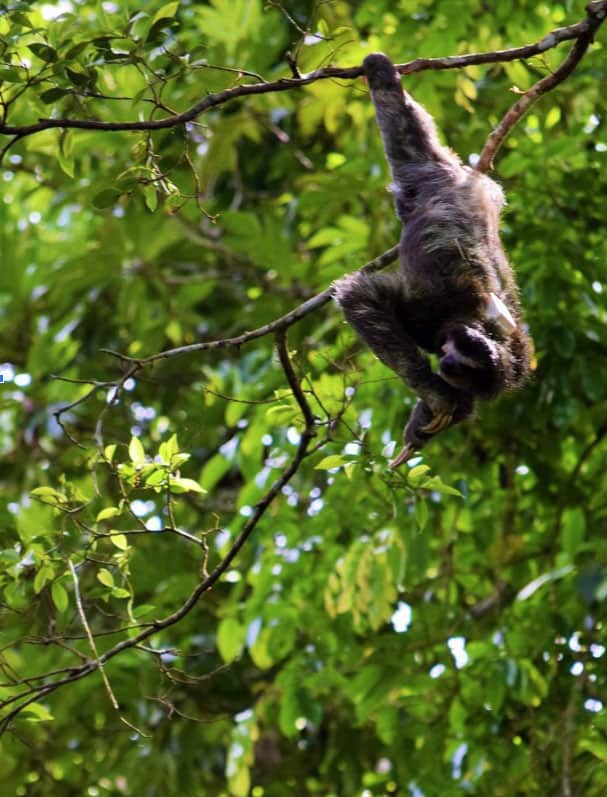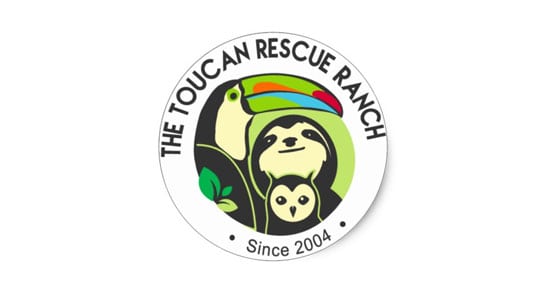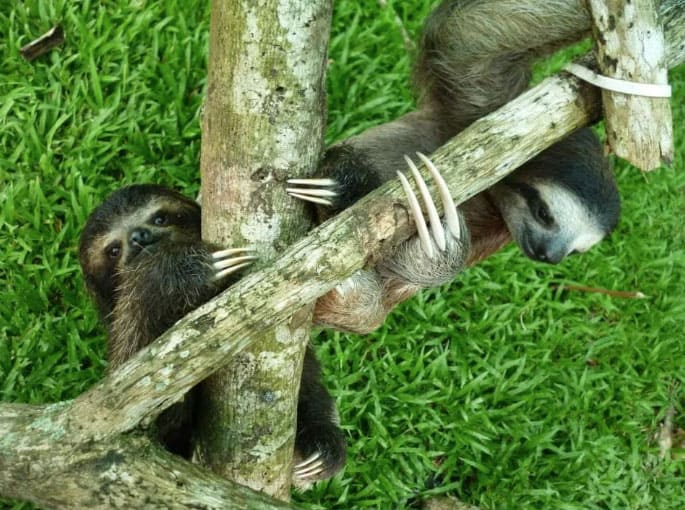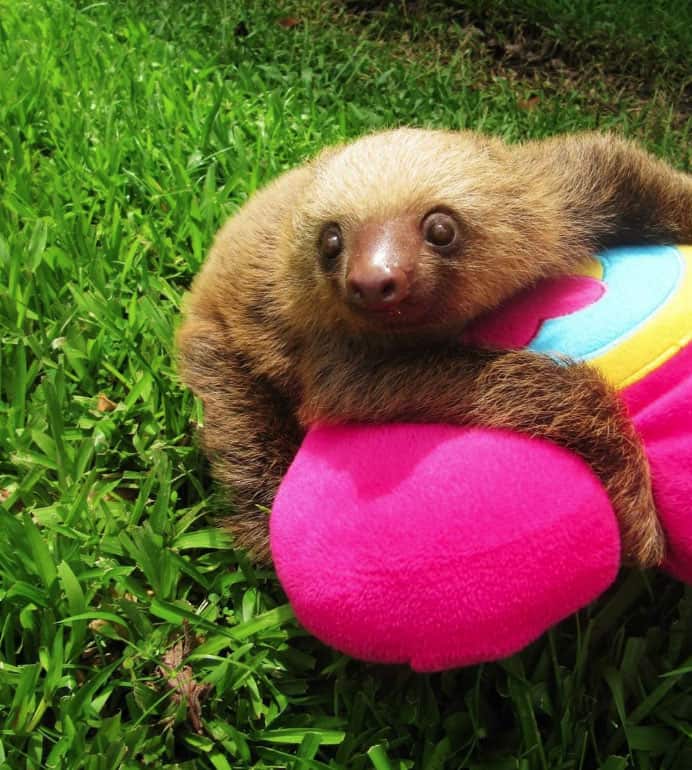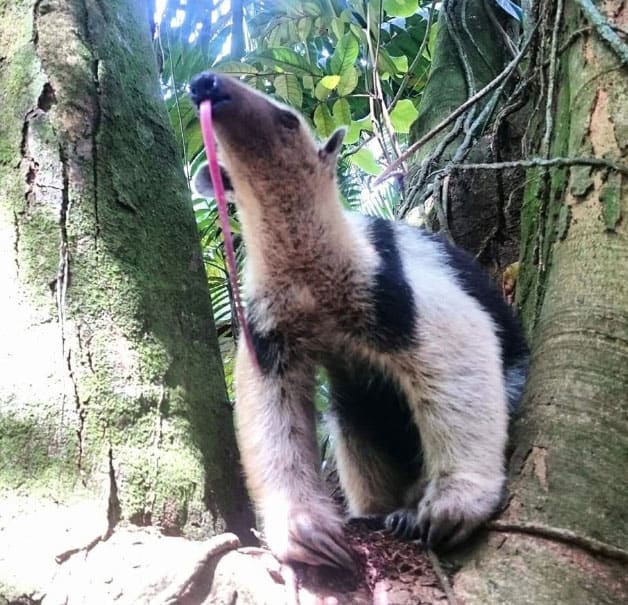Costa Rica Sloths: An Expert Guide To Where to Find Sloths & Tips
There's no denying, sloths are HOT, and not just because they live in the tropics. Over the past few years, our obsession with these adorable, dopey, smiling, chilled-out creatures has grown. The most beautiful thing is, not only are they cute, but they're also some of the most fascinating animals in Costa Rica.
I have been working with sloths for nearly eight years, and we are still learning about these amazing creatures every day. Six species are living in the Americas -- from Honduras, down -- and we have two different species living right here in beautiful Costa Rica.
You can find the two-fingered Choloepus Hoffmanni, which looks like a cross between Chewbacca from Star Wars and a pig, and the adorable, raccoon masked three-fingered Bradypus Variegatus.
I’ve called them two- and three-fingered rather than toed; that’s because all sloth species have three toes. The difference is on their hands, not their feet.
But, where is the best place to hang out with a Sloth? Well, right here in Costa Rica. Costa Rica is a mecca for wildlife tourism, and it’s #1 most wanted is the Sloth.
They will be hanging above your hotels or eating blissfully in the canopies of the national parks. It's also not uncommon to see one crossing the road -- cue all the 'why did the Sloth cross the road' jokes. So, how do you see Sloths in Costa Rica? Honestly, the best tip, slow down and lookup.
Best places to see sloths in the wild in Costa Rica
Here are three popular sloth hangouts you are almost guaranteed to get up close and personal with some wild sloth action. Just respect their area and observe; no selfies, please. You wouldn't want anyone breaking in your house and taking selfies while you ate your salad.
La Fortuna Hanging Bridges
Not only does La Fortuna have stunning views --I will never get bored of seeing the gorgeous Arenal Volcano, but you can also spot a ton of wildlife there, including sloths and a large variety of bird species. One of my favorite places to head to is the Mistico Hanging Bridges, which puts you at eye level with the canopy, and hopefully, sloths.
What do I do when I see a sloth?
First and foremost, make sure you give them at least 2-meters of space. Sloths are very sensitive and don't like loud noises. Getting too close also frightens them. Make sure you don't use the flash on your camera and just sit back, relax and watch the sloth do its thing.
You could also be fortunate and catch the sloth coming down for its weekly poo! During this time, they come all the way down from the tree to the ground, wiggle their butts back and forth while doing the world's cutest poo dance. And in the process, they can lose up to a third of their body weight at a time. Now that's a good poo.
What can I expect to see?
Most likely, you will see the Sloths curled up in a ball in a tree having a nap. But, you can also see them eating in the canopy, coming down to change trees, and possibly even a mom with a baby!
Speaking of Napping . . .
Sloths have a reputation for being lazy, their Spanish name, Perezoso, translates literally into 'lazy bear,' but these creatures are far from lazy, they're stealthy.
Sloths eat leaves, and that's not the most nutritional diet out there.
Think of it like you only being able to eat lettuce all day; you'd be sluggish too.
Most animals that have a diet of leaves, like koalas, sleep an amazing 20 hours a day to help combat their low energy diet. The humble sloth, in comparison, sleeps only around 10 hours. Yes, you read that right.
It is a common myth that sloths sleep a lot. Most sources say anywhere from 18-22 hours, but research conducted on wild sloth behavior has proven otherwise.
So actually, they move around at a ‘sloth's’ pace as a clever way to save energy. Sloths can move quickly; they are choosing not to. They're also slow for a few other reasons - the most important one being predators.
Slothy Camo
The majestic harpy eagle and the jaguar are both predators to sloths, and they are visual hunters. So, by moving slowly, the sneaky sloth remains undetected. Sloths also cannot sweat or shiver, so they don't produce body odor -- seriously, how good does not sweating sound?
You may have also noticed the sloth's green color. Most people believe that sloths grow algae because they are soooo sloooow, but their hair is specially designed to produce fungi. There are over 70 different types of unique fungi that grow in their hair, which turns the sloths green, helping them camouflage themselves like a tree, cleverly hiding from their predators.
Recent studies on these fungi have also shown that, not only is it antibacterial, but that it may cure breast cancer. Therefore, not only are sloths incredibly cute, but they may have the ability to help cure cancer in their fur – all because they are trying to remain hidden. Pretty amazing.
Can I hold or touch a Sloth?
One of the most common questions I get is, "Can I hold/pet a sloth?"
Unfortunately, No. Even people who work with sloths try to minimize the contact they have with them. This is because, even though sloths look cute and cuddly, they HATE being touched.
Sloths are solitary animals, and most wild animals don’t particularly like being around humans. However, sloths, whether wild or hand raised, get tachycardia when handled by humans. This means, as soon as you even approach them, their heart starts to race at dangerous levels.
However, due to their smiling demeanor, they always look like they're enjoying it, but inside, it is causing the animal a great deal of stress.
Sadly, if you go to any organization that lets you hold a sloth, it is not for the benefit of the animal, and it is harming them. And, who wants to make sloths sad?
The best place to admire them is happily munching leaves in a tree, maybe having a good stretch, or blinking contentedly at you and wondering, “what exactly is all the fuss about?”, as you take 1000 pictures of them.
Remember not to interact with the wild sloths. Not only could you be at risk of getting bitten, but you will also be breaking the law. Sloths, and all wild animals, are heavily protected in Costa Rica.
If you do want to see sloths up close and personal, there are a couple of excellent institutions that rescue and rehabilitate sloths.
Going to a wildlife rescue will allow you to get your fill of them while also helping an organization that is working to save wildlife in Costa Rica.
Wildlife Center Recommendations
Jaguar Rescue Centre
Get close to a variety of animals on a guided tour around this rescue facility. The animals are mostly returned to the wild after being rehabilitated, where possible.
Address:
In front of Villas del Caribe, Limón, Punta Cocles
Phone:
2750 0710
Web:
https://www.jaguarrescue.foundation/en-us/
The Sloth Sanctuary
This is the first place in the world that rescued sloths, nearly 30 years ago. You can take a tour and see their sloths, as well as enjoy a canoe tour of the river. Again, where possible, the Sloth Sanctuary releases and rehabilitates the sloths that come to their facility.
Address:
Route 36, 30 km South of Limón Limon, 7302
Phone:
2750 0775
Web:
http://www.slothsanctuary.com/
Toucan Rescue Ranch
The Toucan Rescue Ranch does a variety of walking tours, allowing you to view all of the wild animals that they rescue -- Cup of coffee and snack provided. Sloths and coffee, what a great combo.
Address:
Off of Route 112 near downtown San Josecito, Heredia
Phone:
2268-4041
Web:
https://toucanrescueranch.org/
‘Fast’ Sloth Facts
The two- and three-fingered sloths that we can see today are 33 million years apart. This means that we humans are more closely related to BABOONS than the two- and three-fingered sloths are to each other.
Many people believe that Sloths are related to monkeys or bears, but they are, in fact, Xenarthrans. In Latin, this means strange joints. Sloths, anteaters, and the armadillo all have additional vertebrae that no other mammal has. So yes, they are related to anteaters and the armadillo -- even I find that one a tad weird.
Sloths are not the fastest, especially on the ground, but they are excellent swimmers – particularly the three-fingered. In Panama, they can be seen swimming between islands, looking for a new tree, or love.
Their common ancestor, the Giant Ground Sloth (Megatherium), was around 6-7 meters tall and weighed over 6 tonnes. And, who likes Avocados? Well, you can thank the Giant Ground Sloth.
Sloths will fall out of the tree an average of once a week when the branches break, and no, they don’t mistake their arms for tree branches, as some assume. However, they are great at falling, sometimes falling over 100ft, hitting the ground, bouncing, and not a single broken bone. Not to say they aren’t confused about how they got to the ground; it is the quickest they’ve ever moved.
Their four-chambered stomachs, which takes nearly a month to digest a single leaf, means there is a lot of, well, gas and gas makes you float. Plus, the three-fingered sloth has two more vertebrae in its neck than any other mammal.
They were one of the few animals that could eat the avocado whole. They would then poop the seeds throughout Central & South America; so, thanks Megatherium for the Guacamole!
We’ve talked a little about how sloths come to the ground to poop but not why. This is very strange for an arboreal mammal, particularly one that is trying to save energy and remain undetected by their predators.
The main reason they make this treacherous journey is for mating. It is hard to find a mate, but especially when you are solitary, in a tree, hiding from a Harpy Eagle! So, when the females are in heat, they come to the ground to scent-mark using their poo & wee, letting the male sloth know they are in that tree. After all this effort to find a mate, the actual mating is the quickest thing they do besides falling from trees; it’s over in about 10 seconds.
In fact, it has two more than a giraffe. Excellent for sticking your neck far out of the water when you’re swimming, but it also means they can turn their heads 270 degrees.
There are so many more things to learn about this incredible animal. So, if you do want to learn more about sloths, head to www.slothconservation.com for more information from the leading sloth foundation in the world.
About the Author:
Sarah Robinson is originally from the UK and has been working with both captive and wild Sloths for nearly eight years. She works in Costa Rica on Sloth conservation and education.




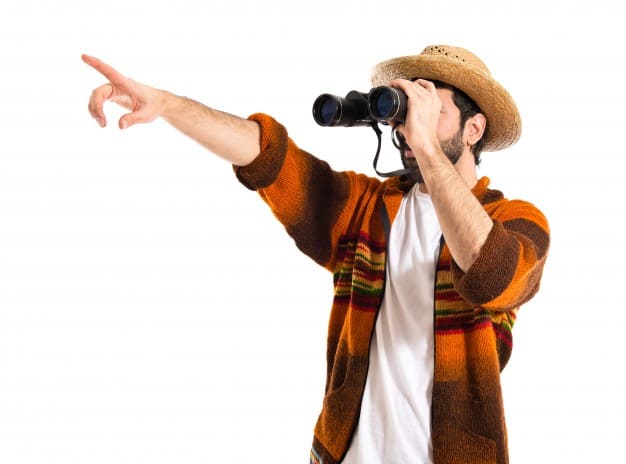


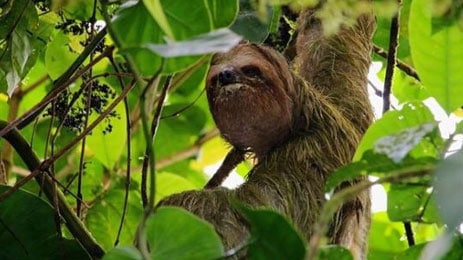
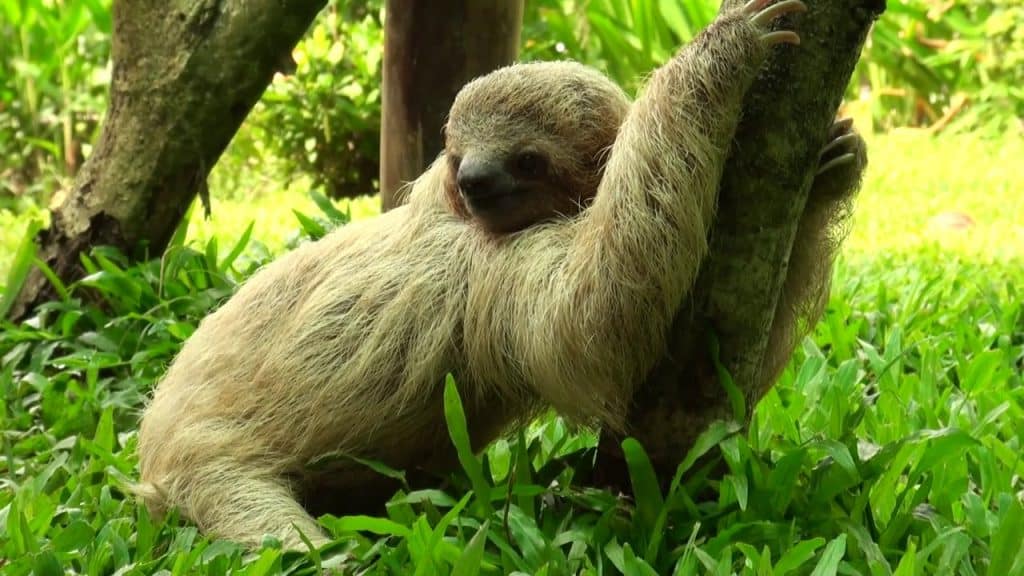


 Get More Out of Costa Rica
Get More Out of Costa Rica